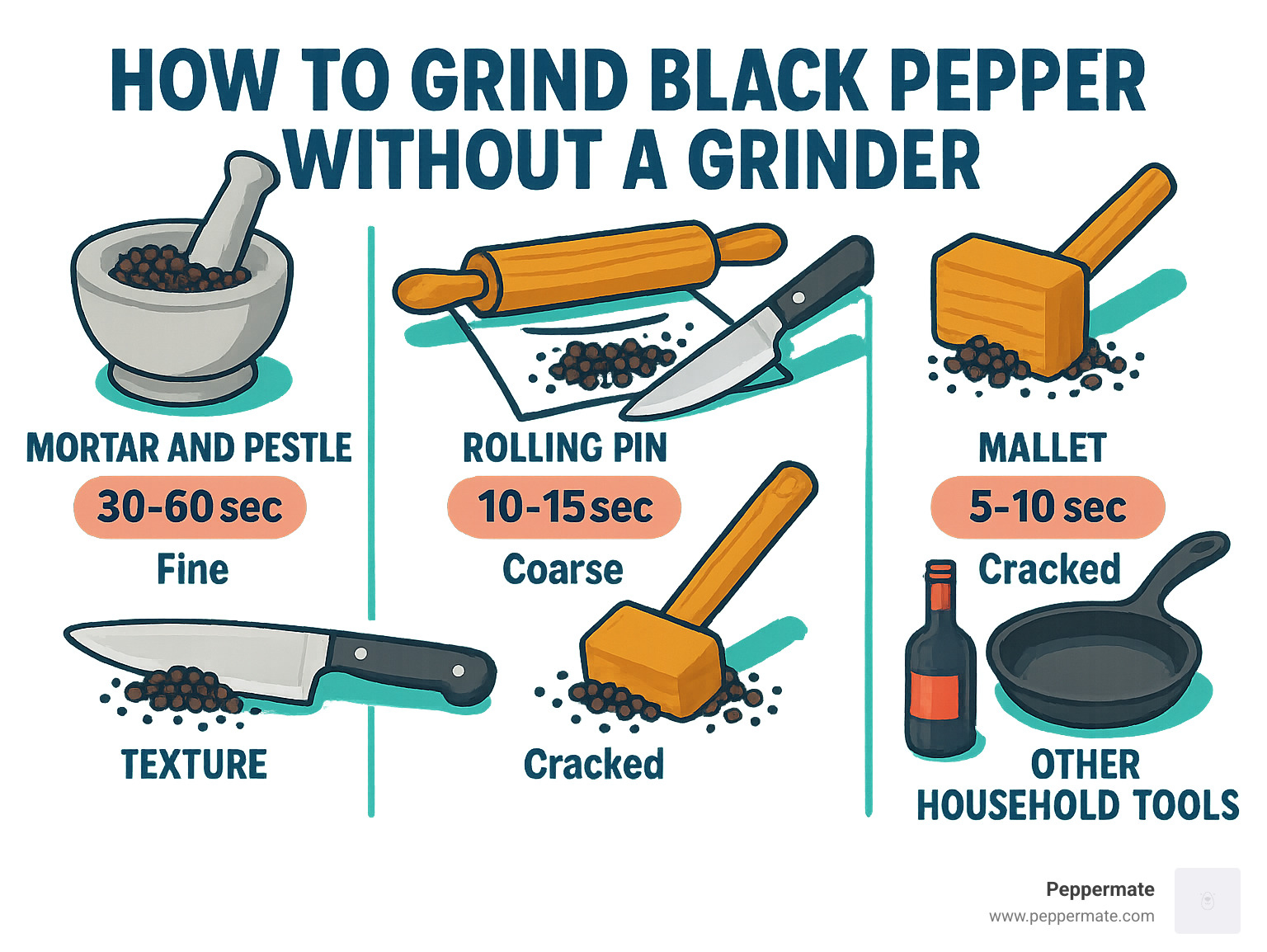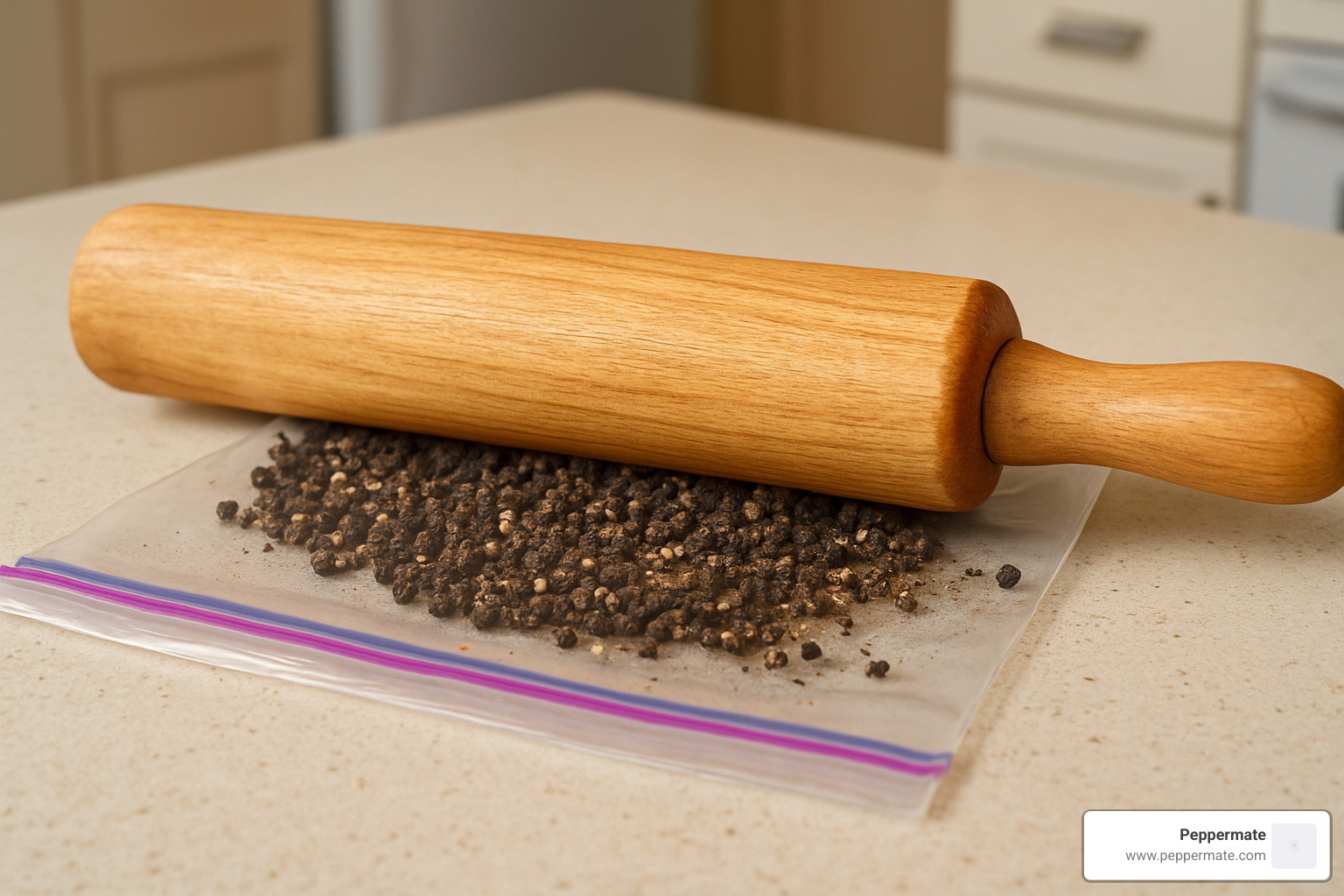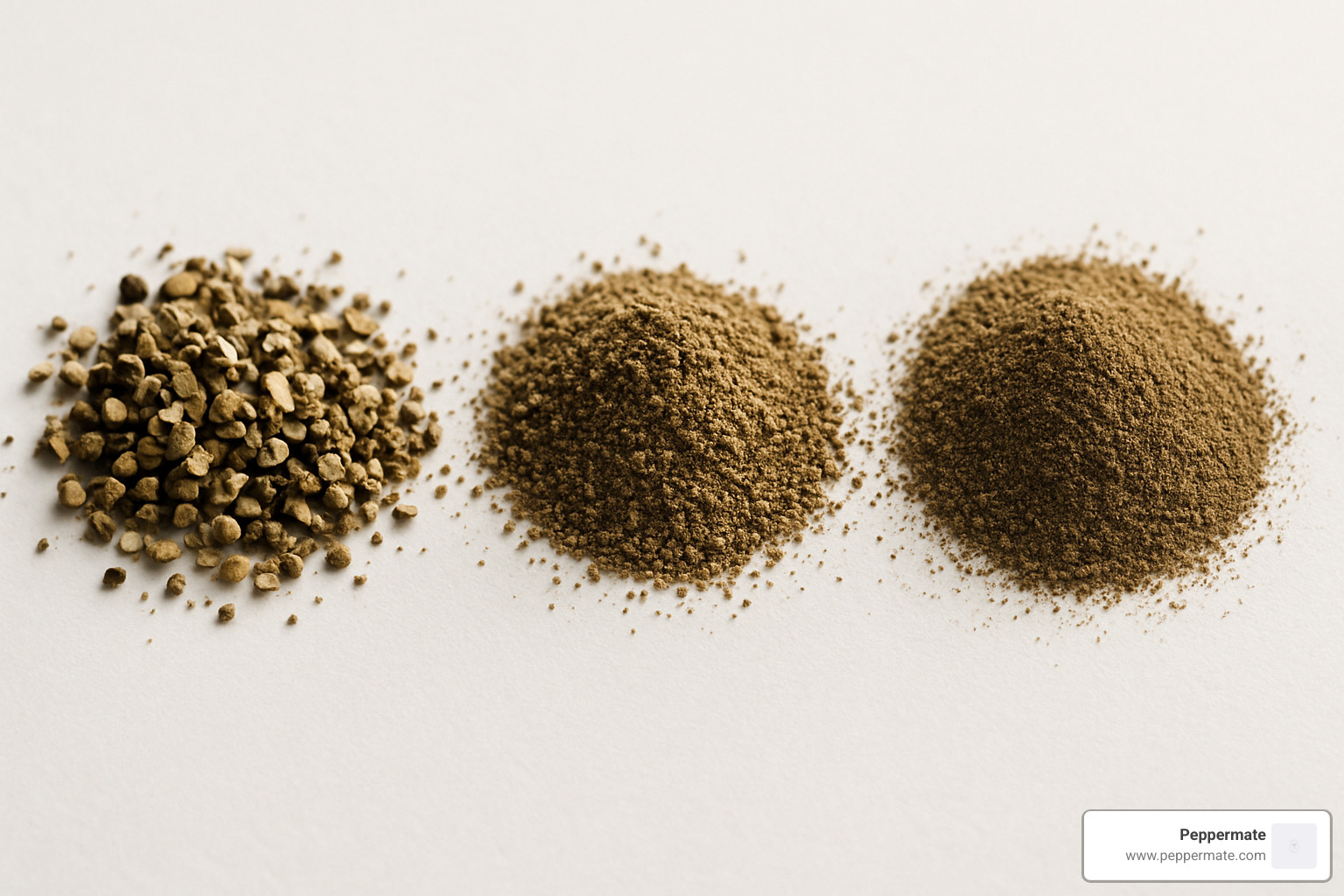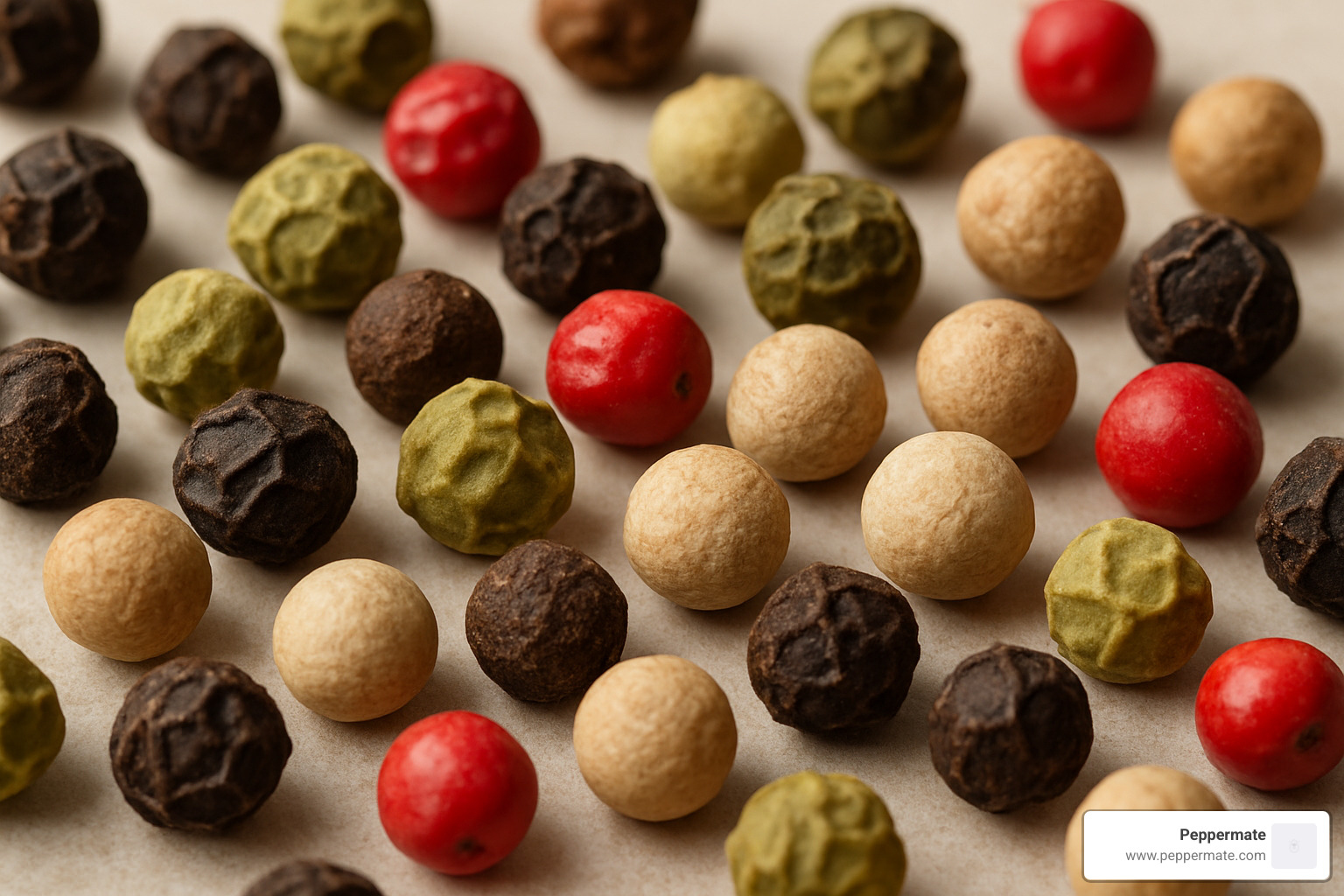Fresh Pepper in a Pinch: No Grinder, No Problem
How to grind black pepper without grinder is easier than you might think. Here are the quickest methods when you're in a bind:
- Chef's Knife - Place peppercorns on a cutting board and crush with the flat side of a knife
- Mortar and Pestle - Grind peppercorns using circular motions until desired consistency
- Plastic Bag + Rolling Pin - Seal peppercorns in a bag and roll/crush with a rolling pin
- Heavy Object - Use a wine bottle, glass, or skillet bottom to press and crush
- Coffee Grinder - Pulse peppercorns briefly (clean thoroughly afterward)
- Blender/Food Processor - Works for larger quantities (¼ cup minimum)
Ever reached for your pepper mill only to find it broken, missing, or empty? We've all been there. That recipe calling for freshly ground pepper isn't going to season itself, and pre-ground pepper from the store just doesn't deliver the same punch of flavor. Thankfully, your kitchen is full of tools that can step in as emergency pepper grinders.
Freshly ground pepper isn't just a chef's preference—it's scientifically superior. When peppercorns are ground, they release volatile oils and compounds that begin to dissipate almost immediately. That's why ground pepper loses its kick after about 3 months, while whole peppercorns can maintain their flavor for years when stored properly.
I'm Joseph Rosenblatt, founder of a premium spice brand with years of experience crafting global-inspired blends, and I've tested countless methods for how to grind black pepper without grinder tools when developing recipes in challenging kitchen environments. My experience has taught me that simple household items can produce surprisingly professional results when you're in a flavor emergency.

Why Freshly Ground Pepper Beats the Pre-Ground Stuff
There's a world of difference between pre-ground pepper that's been sitting on a shelf and the vibrant burst of flavor from freshly cracked peppercorns. When peppercorns remain whole, they're like nature's perfect spice capsules, sealing in all those precious volatile oils and compounds—especially piperine, the magical component that gives pepper its distinctive heat and character.
The science behind this is fascinating. Once you crack or grind a peppercorn, those aromatic compounds immediately begin to escape into the air. It's not just a subtle difference—studies from the National Center for Biotechnology Information have shown that piperine and other compounds start degrading within hours of grinding. After about three months, pre-ground pepper has lost much of what makes it special.
The fresh pepper advantage is noticeable in three key ways:
Your nose knows it first—freshly ground pepper releases an intense, fruity aroma that fills your kitchen. Then your taste buds find the complete flavor profile with floral, woody, and spicy notes that simply don't survive in the pre-ground version. Finally, there's that pleasant heat that dances on your tongue rather than the dull warmth of aged ground pepper.
I've found that buying whole peppercorns in bulk is not just better for flavor—it's easier on your wallet too. While the initial cost might be higher than a small jar of pre-ground pepper, the flavor lasts significantly longer. In our test kitchens, we've confirmed that properly stored whole peppercorns maintain their quality for up to three years when kept in a cool, dark place.
If you're serious about flavor, the extra few seconds it takes to grind pepper fresh is absolutely worth it. Even when using improvised tools to grind pepper, the result will still outshine pre-ground versions. That's why knowing how to grind black pepper without grinder tools can be such a valuable kitchen skill—you'll never have to compromise on flavor, even when your proper grinder isn't available.
The difference is so dramatic that once you experience truly fresh pepper, you'll find it hard to go back to the pre-ground stuff. It's one of those small kitchen upgrades that pays massive dividends in your cooking, elevating even the simplest dishes with minimal effort.
How to Grind Black Pepper Without Grinder – 7 Proven Methods

When your pepper mill decides to quit on taco Tuesday or you're cooking in a vacation rental with bare-bones equipment, don't panic! I've tested these seven reliable methods that will save your recipe and your sanity. Each approach creates a slightly different texture, so I've organized them from finest to coarsest grind, with notes on which cooking scenarios they shine in.
Quick-Glance: how to grind black pepper without grinder on the fly
Need the short version? Here's your emergency pepper-grinding toolkit:
- Mortar and Pestle: Your best bet for controlling texture; preserves those essential oils
- Rolling Pin + Bag: The 30-second solution; perfect for medium batches
- Chef's Knife/Meat Mallet: Ideal for small amounts; works great while camping
- Heavy Object Press: The "everyone has something" method; uses common items
- Coffee Grinder: Handles up to 4 oz at once; creates very fine pepper powder
- Blender/Food Processor: Your bulk-batch hero; needs at least ¼ cup to work properly
- Sieve Method: The extra mile for super-fine results; restaurant-quality finish
Method 1: Mortar and Pestle Fundamentals
The humble mortar and pestle might be ancient technology, but there's a reason it's survived thousands of years. If you have one tucked away in a cabinet, you've struck pepper-grinding gold—this method gives you unparalleled control over your grind size.
Start by placing just a small amount of peppercorns in the mortar (about 1-2 teaspoons). Hold the pestle firmly and press down while moving in a circular motion. The trick is to begin with gentle pressure to crack the peppercorns, then gradually increase as you continue grinding.
For the finest results, work in small batches with consistent pressure. The rough-textured interior of a traditional mortar works best, creating the perfect amount of friction. If yours is smooth, try adding a pinch of coarse salt as an abrasive helper.
What makes this method special is how it preserves those precious volatile oils. Unlike electric methods that generate heat (causing some compounds to evaporate), the mortar and pestle maintains more of pepper's complex flavor profile. This is precisely why many professional chefs still swear by this ancient technique for certain spice preparations.
Method 2: Rolling Pin Inside a Zip Bag
Need a decent amount of cracked pepper in under 30 seconds? The rolling pin method is your new best friend.
Simply place your peppercorns in a zipper bag, squeeze out as much air as possible, and seal it tight. Lay the bag on a stable surface, position your rolling pin on top, and apply firm, even pressure as you roll over the peppercorns. The beauty of this method is its flexibility—use less pressure for coarser cracks or roll longer with more pressure for finer grounds.
Pro tip: If you're environmentally conscious, skip the plastic and place your peppercorns between two sheets of parchment paper instead. You'll need to be a bit more careful about escapees from the sides, but Mother Earth will thank you.
Method 3: Chef's Knife or Meat Mallet Smash
When you just need a teaspoon or two of freshly ground pepper, nothing beats the simplicity of the knife method.
Place your peppercorns in a small pile on a cutting board. Lay the flat side of your chef's knife over them, then press down firmly with the palm of your hand. Rock the knife slightly to ensure all peppercorns get crushed. For a finer grind, continue crushing with more pressure.
If you have a meat mallet, try this clever variation: place peppercorns in a coffee filter, fold it to contain them, then use the flat side of the mallet to crush with controlled pressure. The coffee filter keeps everything contained while allowing you to monitor your progress.
Safety first: Always keep your fingers safely away from the knife edge and ensure your cutting board is stable. A damp towel underneath prevents slipping and potential accidents.
Method 4: Heavy Skillet, Jar, or Wine Bottle Press
No rolling pin? No worries! Almost any heavy, flat-bottomed object in your kitchen can transform into an emergency pepper grinder.
Place your peppercorns between two flexible cutting mats or inside a plastic bag on a stable surface. Press down firmly with the flat bottom of a heavy skillet, jar, or wine bottle. The key is applying even, downward pressure—don't slam or pound.
"If you're using a glass object like a drinking glass or wine bottle, be especially careful to apply pressure straight down, not at an angle, to avoid any risk of breaking the glass," advises our Peppermate test kitchen director in Sydney. This method might take a little longer than others, but it works beautifully when options are limited.
Method 5: Repurposed Coffee Grinder
A dedicated spice grinder is ideal, but that coffee grinder gathering dust in your cabinet works wonderfully in a pinch. This method can process up to 4 ounces of peppercorns at once, producing a much finer and more consistent result than most manual methods.
Make sure your grinder is completely clean and dry before adding peppercorns (no more than halfway full). Instead of continuous grinding, pulse in short bursts and check the consistency between pulses. For finer results, continue pulsing and occasionally shake the grinder to redistribute the peppercorns.
After you're done, clean your grinder by pulsing a small amount of uncooked rice. The rice absorbs oils and removes particles, preventing your morning coffee from tasting like a pepper latte tomorrow.
Method 6: Blender or Food Processor for Bulk Batches
When holiday cooking demands serious pepper quantities, your blender or food processor can handle the job efficiently.
This method requires at least ¼ cup of peppercorns to ensure they reach the blades properly. Pulse in short bursts rather than continuous blending, shaking the blender between pulses to redistribute the peppercorns. For uniform results, sift through a mesh strainer and regrind any larger pieces.
Freshly ground pepper begins losing potency after about five days, so while you can make larger batches with this method, it's best not to grind more than you'll use within a week.
Achieving Powder-Fine Results: how to grind black pepper without grinder into dust
Aiming for that ultra-fine powder like you get in commercial spice jars? You'll need a bit more patience:
Start with any of the above methods to create an initial grind. Then sift the ground pepper through a fine mesh sieve, collecting the powder that passes through. Return the larger particles to your grinding tool and repeat the process. For mortar and pestle grinding, add a pinch of coarse salt as an abrasive to help break down the peppercorns more efficiently.
Be patient—achieving a true powder consistency without industrial equipment takes time. Commercial spice companies use large mills followed by vibrating sieves to classify particles by size. Your repeated grinding and sieving is the home cook's version of this professional process.
While these methods will certainly get you through a pepper emergency, there's nothing quite like the convenience of a quality grinder for everyday use. Peppermate's ceramic mechanism grinders provide consistent results without the workout—but it's always good to have these backup techniques in your culinary arsenal for those "oops" moments!
Choosing Your Texture: Cracked, Coarse, or Fine?

When it comes to pepper, size really does matter! The texture you choose isn't just about appearance—it fundamentally changes how your dish tastes. Let me walk you through the pepper texture spectrum and help you pick the perfect grind for your cooking needs.
Cracked Pepper (those chunky 2-3mm pieces) brings bold texture and visual drama to your dishes. This is your go-to for classic steak au poivre or when you want those beautiful black flecks adorning your salad. To achieve this texture without a grinder, a gentle smash with a knife or light pressure with a rolling pin works perfectly. What I love about cracked pepper is how it creates these delightful little flavor explosions in each bite.
Coarse Ground (the middle-road 1-2mm pieces) strikes that perfect balance between flavor impact and distribution. This versatile texture shines in soups, stews, and marinades where the pepper gradually releases its flavor during cooking. Your mortar and pestle is the champion tool here, though a coffee grinder with just a few pulses also does the trick. I find coarse ground perfect for those long, slow-cooked dishes where you want the pepper flavor to develop and meld over time.
Fine Ground (those tiny 0.5mm or smaller particles) distributes evenly throughout your dish, providing immediate flavor in every bite. This is essential for baking, spice blends, and finishing dishes where you want consistent seasoning. Creating truly fine pepper without a grinder takes some effort—repeated grinding with a coffee grinder or mortar and pestle, followed by sieving, will get you there. The payoff is worth it when you need that perfectly uniform seasoning.
The texture you select affects not just how your dish looks but also the flavor release timeline. Coarser grinds slowly unfurl their complex flavor notes during cooking, while finer grinds deliver an immediate peppery punch. This is why professional chefs are so particular about their pepper texture—it's a crucial flavor control point.
| Grind Type | Particle Size | Best Uses | Best DIY Method | Typical Grind Time |
|---|---|---|---|---|
| Cracked | 2-3mm | Steak crusts, visual impact | Knife smash, light rolling pin | 30 seconds |
| Coarse | 1-2mm | Soups, stews, marinades | Mortar & pestle, brief coffee grinder | 1-2 minutes |
| Medium | 0.5-1mm | All-purpose, most recipes | Coffee grinder, thorough mortar work | 2-3 minutes |
| Fine | <0.5mm | Baking, spice blends, finishing | Repeated grinding & sieving | 3-5 minutes |
For controlling your grind size without a proper mill, the sieve technique becomes your best friend. After your initial grind, pass the pepper through a fine mesh sieve. The particles that pass through are your fine grind, while those that remain can be reground for a more uniform result. This simple step makes a remarkable difference in achieving consistent texture—something I've found particularly helpful when preparing spice rubs where texture uniformity matters.
How to grind black pepper without grinder techniques will naturally produce less uniform results than a dedicated grinder with adjustable settings. But with a bit of practice and patience, you'll develop an intuitive feel for achieving your desired consistency with whatever tools you have on hand.
Safety, Cleanup & Storage Hacks
Let's face it – grinding pepper without proper tools can get messy. I've learned this the hard way, with black specks covering my kitchen counter and a sneeze attack that lasted five minutes! But with a few simple precautions, you can keep your impromptu pepper grinding session safe and tidy.
When crushing peppercorns, always place a protective towel layer underneath your work area. This simple step has saved me countless cleanup headaches. Remember to keep your face at a safe distance too – those fine pepper particles love to find their way into unsuspecting eyes and noses, triggering some impressive sneezing fits. I recommend working in a well-ventilated area if you're grinding more than a tablespoon.
Safety always comes first when improvising with kitchen tools. Ensure your cutting board won't slip by placing a damp cloth underneath. When using glass objects like wine bottles, apply even downward pressure – I once had a bottle slip sideways, and let's just say the resulting mess was not worth the freshly ground pepper!
Before filling plastic bags with peppercorns, give them a quick inspection for weak spots. Trust me, finding a tear after you've started crushing creates a cleanup job nobody wants. For extra protection, double-bag or use freezer-grade bags which tend to be more durable.
Cleanup becomes much easier with a few tricks in your arsenal. My favorite hack for cleaning a coffee grinder is the rice cleanse method – simply grind a tablespoon of uncooked rice after your peppercorns. The rice absorbs the oils and removes stubborn particles that might otherwise flavor your next batch of coffee. For wooden cutting boards that have absorbed pepper oils, a quick scrub with lemon and salt works wonders.
For blenders or food processors, fill halfway with warm water and a tiny drop of dish soap, pulse briefly, then rinse thoroughly. This prevents flavor transfer to your next smoothie or sauce.
Proper storage preserves your pepper's potency. After all that work grinding, you'll want to maintain maximum flavor! Store freshly ground pepper in airtight glass jars away from heat and light. The pantry is perfect, but keep those jars away from the stove where heat and steam can degrade quality.
While it's tempting to grind in bulk, how to grind black pepper without grinder methods work best when you only process what you'll use within a few days. Freshly ground pepper starts losing its punch almost immediately, with significant flavor loss after about 3 months.
For measuring freshly ground pepper accurately, check out this helpful guide on proper pepper measurement. It's surprising how much variation can occur between different grinds!
If you find yourself regularly improvising pepper grinding methods, consider setting aside a dedicated coffee grinder exclusively for spices. Label it clearly – unless you enjoy cinnamon-flavored coffee or coffee-flavored cinnamon!
Whole peppercorns, meanwhile, will maintain their quality for years when stored properly in a cool, dark place. This makes buying in bulk both economical and sustainable – less packaging waste and fewer trips to the store. Your future self (and your wallet) will thank you for thinking ahead.
Frequently Asked Questions about Grinding Pepper Without a Mill
Does toasting peppercorns first make grinding easier?
Ever tried crushing peppercorns only to have them bounce around stubbornly? A quick toasting session might be your answer. Lightly toasting peppercorns before grinding not only makes them more brittle and easier to crush, but also wakes up their essential oils for improved flavor.
To toast peppercorns properly, just heat a dry skillet over medium heat, add your peppercorns, and gently shake the pan for 1-2 minutes. You'll know they're ready when they become wonderfully fragrant—just be careful not to burn them! Let them cool completely before grinding, as hot peppercorns can become oily and difficult to work with.
The heat from toasting creates tiny fractures in the peppercorn shells, making them much more cooperative when you're trying to grind them without a grinder. Plus, your kitchen will smell amazing!
How do I stop pepper from flying everywhere?
We've all been there—what started as a simple pepper-grinding task turns into a countertop covered in black specks and a sneezing fit. The secret to keeping things tidy lies in proper containment.
Always enclose your peppercorns in something while crushing them. A zip-top bag works wonders, but parchment paper or even a coffee filter can do the trick in a pinch. When using a knife method, try cupping your non-dominant hand around the blade edges (safely away from the sharp side!) to create a natural barrier.
Work with smaller batches rather than trying to crush a mountain of peppercorns at once, and apply steady, even pressure instead of forceful whacks. If you're using a mallet or heavy object, placing a kitchen towel over your work area can catch any escapees. And when using a blender, give those pepper particles about 30 seconds to settle before opening the lid—your sinuses will thank you!
Can I grind other spices using these same methods?
Absolutely! Once you've mastered how to grind black pepper without grinder tools, you've essentially open uped the ability to freshly grind almost any whole spice. Just keep in mind that different spices have different textures and hardness levels, so you might need to adjust your technique slightly.
Hard spices like nutmeg and cinnamon sticks are the tough guys of the spice world. They'll put up more resistance, so your best bet is a coffee grinder or a sturdy mortar and pestle. Medium-hard spices such as coriander seeds and allspice berries play nicely with all the methods we've covered.
For softer spices like fennel and anise seeds, use a gentler touch to avoid turning them into paste. And those sticky spices like cardamom? Remove the seeds from their pods first, then grind just the seeds for best results.
When creating spice blends, I've found that grinding each spice separately to your desired consistency before mixing gives the most professional results. Different spices break down at different rates, and grinding them together often results in some being powder while others remain nearly whole.
With these techniques in your culinary toolkit, you'll never be at the mercy of a missing or broken pepper mill again. And while these methods work wonderfully in a pinch, when you're ready for a more permanent solution, Peppermate's lifetime-warranty grinders with their adjustable ceramic mechanisms make daily spice grinding a true pleasure rather than a kitchen hack.
Conclusion
There's something magical about the aroma that fills your kitchen when you crack open fresh peppercorns. Now that you know how to grind black pepper without grinder tools using everyday items in your kitchen, you never have to settle for flat, lifeless pre-ground pepper again.
Whether you've mastered the quick chef's knife smash for a pinch of cracked pepper on your steak, or you've become adept at using a rolling pin to prepare a batch for your next dinner party, these techniques ensure flavor never takes a backseat in your cooking. Each method has its sweet spot – the mortar and pestle preserves those precious volatile oils for your curry paste, while the coffee grinder method delivers the fine powder needed for delicate baking recipes.
I've found that with a little practice, these improvised grinding methods become second nature. You might even find you prefer the control of crushing peppercorns by hand for certain dishes! The texture and intensity you can achieve with manual methods often surpasses what's possible with basic pepper mills.
Of course, while these DIY approaches are perfect in a pinch, for everyday cooking convenience, a quality grinder makes seasoning effortless. Peppermate's ceramic grinders feature adjustable settings that let you dial in exactly the coarseness you need, with a clear base that shows when you're running low. They're built to last – backed by a lifetime warranty that reflects our confidence in their durability.
But the heart of good cooking isn't about having every gadget – it's about understanding ingredients and finding creative solutions when needed. Whether you're in your fully-stocked kitchen or improvising at a vacation rental, these techniques ensure the bright, complex flavor of freshly ground pepper is always within reach. Your dishes (and your dinner guests) will certainly appreciate the difference!




